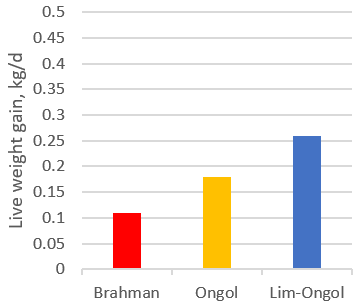
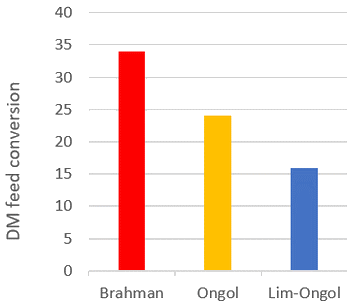
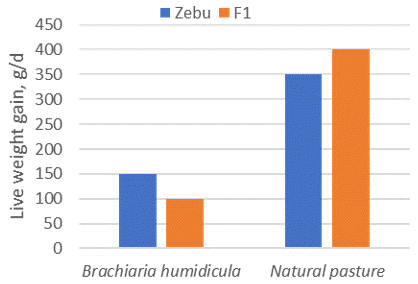
(Lopez 2000; Personal communication)
| Livestock Research for Rural Development 33 (7) 2021 | LRRD Search | LRRD Misssion | Guide for preparation of papers | LRRD Newsletter | Citation of this paper |
In this presentation, we have considered some of the feed resources available in tropical countries for beef cattle production and how they are best utilized. It is stressed that the key factor to be considered is the source of soluble and insoluble(bypass) protein, since bypass protein content of the diet determines the efficiency with which the feed energy is used for productive purposes.
One of the virtues of the ruminant digestion is that a major part of the protein requirements can be obtained from microbes that grow in the rumen. Furthermore, as most of these microorganisms can use ammonia as a source of nitrogen, ammonia-N (derived from urea) together with carbohydrates such as starch but also cellulosic materials can provide a major part of the total protein requirement. An ideal situation is experienced where all of the microbial protein-N is sourced from urea and the balance to meet protein requirements for efficient ruminant production is derived from “bypass” protein. Here it is proposed that energy requirements to optimize efficient microbial growth is derived from starch or sugar and not from fiber which is only required in minimal amounts to maintain an efficient rumen function ( to prevent acidosis and or bloat) and provide support for biofilms as hosts for micro-organisms and where orderly breakdown of feed predominates.
In temperate latitudes, energy in a ruminant diet is often sourced from cereal grains and protein from soybean or rapeseed. For the tropics, the ideal energy source is cassava which is potentially superior to cereal grains as almost all the root is composed of starch and with negligible protein which facilitates the optimization of the protein supply sourced from NPN via microbial growth. This complemented by bypass protein sourced from the leaves of trees and shrubs (via carbon-sequestration) is probably the most efficient way to feed ruminants in the tropics.
The above points are those needed in establishing balanced diets that optimize ruminant production and at the same time minimize emissions of methane in ruminants.
Key words: agroindustry, byproducts, cassava, methane, urea
Beef production in tropical countries has traditionally been focussed on grazing of pastures, either natural or of introduced varieties. However, even under the best conditions and management, grasses will not provide sufficient nutrients to fulfill the requirements of most breeds of beef cattle. This is demonstrated in the results of an experiment in Indonesia. The beef breeds compared in Figures 1 and 2 have a genetic potential to grow more the 1 kg/d but on a diet exclusively of Brachiaria humidicula the best result was only 0.25 kg/d while theBrahman – a breed developed specifically for the tropics - gain only 100g/d and had a feed conversion requiring 35 kg DM/kg LW gain.
The reasons for these differences can be seen in Figure 3 which shows that cattle grazed exclusively on Brachiaria humidicula grew at only 150 g/day. In contrast, similar animals grazed on natural pasture gain 350 g/d. The relationship between genotype and feed supply is evidenced t by the fact that animals of superior genetic merit for growth (F1 Brown Swiss* Zebu) grew faster the “pure” Zebu in natural pasture but had a lower growth on Brachiaria. The explanation is in the criterion of: "improvement”. For improved” pasture species the criteria probably were “DM yield” and perhaps “content of crude protein”. But, as we have shown, “quality” of a grass is more appropriately described by the content of “bypass protein” as reflected in protein of low solubility. Natural pasture is invariably a broad mixture of species including legumes and herbs that will be richer in bypass protein than pure grass species.
To the criticism of low productivity and efficiency of grass-based diets there is the increasing appreciation that low levels of ruminant productivity are directly linked with high levels of emissions of methane. This is partly because enteric methane continues to be produced irrespective of the productive state of the animal; and also, because diets based on grasses inherently produce more methane since digestion is almost entirely by rumen microbial fermentation - and the associated production of methane – with very little occurring in the intestines and cecum where methane us not produced.
The conclusion is that feeding systems for ruminants should be based on feed resources that inherently produce low levels of methane relative to the total amount of fed that is fermented/digested. This will also favor feeds rich in bypass protein as this is the key factor that determines: escape of nutrients from the rumen and their more efficient utilization by the animal as methane is not produced post-rumen.
 |
 |
| Figure 1. Growth rates of three breeds “fattened” on Brachiaria humidicola as sole diet in Indonesia (Antari et al 2016) | Figure 2. DM feed conversion of three breeds “fattened” on Brachiaria humidicola as sole diet in Indonesia (Antari et al 2016) |
 | |
| Figure 3. Cattle grow faster on natural pasture than on “improved”
Brachiaria humidicula (Lopez 2000; Personal communication) | |
The need for bypass protein is predicated on the understanding that the rumen microbial system is not able to supply all the amino acids and glucose precursors needed by ruminants with high genetic capacity for growth. The question then is: how to ensure that ruminant ls of high genetic capacity for growth receive the nutrients they need to express their potential? The key to this issue is the understanding of the role of bypass protein in the context of the overall supply of amino acids to the animal.
The amino acid supply to the ruminant has two sources: microbial protein produced by growth of microbes in the rumen; and “bypass” or “escape” protein that is mot fermented in the rumen and continues on to the intestines for enzymic digestion. The virtue of the two modes of providing protein to the animal is that the “microbial “protein can be obtained by the rumen microbes using ammonia sourced from low cost dietary NPN such as urea. The critical issue is that in practice only some 50% of the required protein can be sourced from this pathway. The remainder must come from a source of “bypass protein”. For this reason, the identification of sources of bypass protein is the key factor in ensuring high growth rates in ruminant animals.
The final question is: what feed resources are available in a given region of the tropics and how can they be utilized/modifies/supplemented to respond to the guidelines set out above? And if appropriate feed resources are not available, what are best ones to grow?
To this end, we have considered the various feed resources available in tropical countries for beef cattle production and how they are best utilized. We repeat that the key factor is a source of bypass protein since this will determine the degree to which the energy in the feed is used for productive purposes and that methane emissions are minimized. The latter issue cannot over-emphasized as we all must respond to the challenge of “Net Zero’. For ruminant livestock this means increasing productivity and at the same time employing nutritional strategies that will modify ruminant digestion in ways that relate to reduced emissions of methane. We continue to emphasize that these two issues are ae directly related as feeding systems that reduce production of enteric methane will also increase animal productivity and feed utilization efficiency.
The principles to follow in the design of “high-performance-low carbon footprint” feeding systems for ruminant livestock have been described, together with the relevant methods for evaluating these systems (Preston et al 2021).
There is a wide range of feed resources available in the tropics that are suitable for beef cattle (Table 1). We stress that the key factor is supplementation with bypass protein since this will determine the degree to which the feed energy is used for productive purposes.
We stress that trees and shrubs should be the first choice as sources of bypass protein as this will combine the environmental benefits inherent in perennial species that performed as sinks for atmospheric carbon as well as being potential sources of “bypass protein”. This is a desirable objective but is not exclusive as will be apparent in the description of many of the feeding systems that have been developed.
The first sources to be considered are the byproducts from agro-industrial enterprises as there are environmental issues to be considered in their disposal. Feeding them to livestock may be the most appropriate was to dispose of them. It is also desirable that the byproducts are not “exported” when they could use within the country.
There are five major agro-industries in the tropics that produce byproducts with potential use in livestock production. These are defined by the principal products, namely: rice, sugar, starch, edible oils and cotton. In all cases there are byproducts that can be used by livestock Table 1).
|
Table 1. Byproducts available fromAgro-industry |
||||
|
Agro-industry |
Main product |
Byproduct |
Source of? |
|
|
Rice |
Grain |
Straw |
Energy/biochar |
|
|
Bran, polishings |
Protein |
|||
|
Husks |
Energy/biochar |
|||
|
Cassava |
Starch |
Root pulp, foliage |
Energy/protein |
|
|
Sweet potato |
Tubers |
Foliage |
Protein |
|
|
Sugar cane |
Sugar |
Molasses |
Energy |
|
|
“Panela” |
“Cachaza” |
Energy |
||
|
Oil palm |
Edible oil |
Palm kernal cake |
Protein |
|
|
Coconut palm |
Edible oil |
Coconut cake |
Protein |
|
|
Cotton |
Fiber |
Cottonseed cake |
Protein |
|
|
Sisal |
Fiber |
Pulp |
Energy |
|
If byproducts are not available what are the best crops to grow as livestock feed? Examples of this strategy are the production of maize and sorghum in the USA and of barley and rape in Europe. For the tropics we will l provide evidence to support the conclusion of Jarvis et al (2012) that cassava is the most suited for the higher temperatures expected with climate change. The choice of cassava is understandable considering that its origins was in tropical Caribbean countries and Brazil.
The principles that should be followed are that the basal diet should be rich in easily fermented carbohydrate. In most cases it will need to be supplemented with urea and a source of bypass protein. The content of fiber should be the minimum required to maintain normal rumen function: and will automatically be provided for if foliage from trees and shrubs the chosen source of bypass protein is as we suggested in the first paper in this series (Preston et al 2021).
The experiments carried out in the period 1965-72 70 in Cuba led to the recognition that the key to developing efficient feeing systems for ruminants with tropical feed resources was the concept of “bypass” protein. An initial attempt to transfer to Cuba the “Barley Beed” technology (Preston and Willis 1974) developed in Scotand in the period1958-63 was technically successful but economically and politically inappropriate as attempts to grow maize and sorghum, as local replacements for barley, proved to be huge hugely dependent on herbicides and insecticides which had to be imported with scarce foreign exchange.
The option of replacing cereal grains with liquid molasses from the Cuban sugar industry posed a technical challenge but also an opportunity to take advantage of a resource widely available in tropical countries as a byproduct of sugar produced from sugar cane. The research done in Scotland (Whirelaw et al 1963) had demonstrated that the ideal protein for intensification of ruminant growth rates should be of low solubility and of high biological value. Appreciating that the fish meal (the ideal protein source), used by Whitelaw and Preston (1963), had been imported from Peru pointed to a source of s protein readily available in the Latin-American region.
Acceptance of urea to supply the nitrogen required for rumen microbial synthesis of the balance of the required protein was the other major decision that was that taken. The results of the experiment carried out in the “Instituto de Ciencia Animal” in Cuba (Figure 4) confirmed this hypothesis, demonstrating that the optimum combination was about 30% of the dietary nitrogen from fish meal and the remaining 70% from urea. The absence of fiber in molasses, urea and fish meal was resolved ed by providing 20% of the diet DM as fresh grass in the feed trough or acquired by restricted periods of grazing. The dependence imported fish meal was resolved by replacing it with “Torula” yeast produced locally by fermentation of molasses. Animal performance was similar to what was recorded with fish meal.
 |
| Figure 4.
Supplementing a molasses-ure dieit with fih meal improves
groth rate and feed conversion of Zebu cattle by 100% (Preston and Willis 19742) |
The research with sugar cane was stimulated by the invention of a technology designed to separate the stalks of sugar cane into two components of contrasting usage: the rind as raw material for construction of particle board and the residual pith seen as a potential feed for livestock. The use of the rind for particle board manufacture was not successful because of the difficulties and expense of removing the residual sugar. Emphasis was then placed on the potential of the pith as cattle feed. It was hypothesized that removal of the lignified rind would significantly improve the feeding value. The experiment to test this hypothesis in cattle was done in in Quintana Roo state in Mexico (Preston et al 1976).
The potential benefits from deriving the sugar cane were assessed by comparing it with the whole plant that was processed in simple forage chopper. Urea as a 20% solution in molasses as added as a source of fermentable nitrogen in both diets.
Rice polishings was the only available candidate as the source of bypass protein. It was assumed that he presence of 15% residual oil in this product would act as a deterrent to rumen microbes thus facilitating the escape of the protein and the starch from the rumen to the lower digestive tract. This hypothesis was proved by the responses in live weight gain according to the level of this supplement (Figure 5).
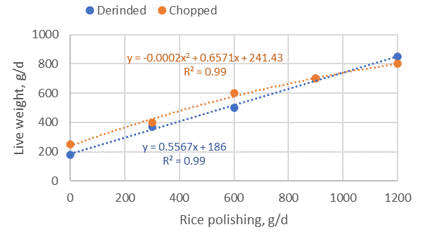 |
| Figure 5. Supplementing basal diets of
chopped whole sugar cane or derinded sugar cane stalk, with urea and increasing quantities off rice polishing (Preston et al 1976) |
The virtue of adjusting response functions to the data is evident in the nature of the response to the supplement on the two contrasting diets. The function was linear for the derinded cane and curvilinear for the chopped whole cane. The implication of these differences is that the derinded cane would be increasingly superior to the whole cane as the level off supplementation with rice polishings was increased. In other words, differences between the two basal diets were only favorably expressed when the “bypass” protein supply was adequate. The urea was enough to provide nitrogen to the rumen microorganisms but “bypass nutrients” (from protein and starch) were needed to active maximum response to the potentially “superior” source of energy from the derinded sugar cane.
The idea of using sugar cane juice as an energy source for ruminants arose from a combination o factors. The basic concept was that sugar cane is perhaps the most efficient crop for sequestering atmospheric carbon into products that can be utilized efficiently in human activities. With a life cycle of about ten years, it is essentially perennial resembling a tree forest but with a higher rate of photosynthesis die to its extensive leaf area.
The traditional sugar mill extracts about two thirds of the available sugar as crystalline sucrose. The remaining sugars are present as glucose and fructose and cannot be crystallized economically, remaining in the residual product as “molasses”. traditionally used as substrate for yeast fermentation to potable alcohol (rum and “aguardiente”) and as animal feed. In Colombia and in other tropical countries, especially Brazil, molasses is almost exclusively fermented to industrial ethanol destined entirely for mixing with gasoline as fuel in internal combustion engines.
It is relevant to recall that the role of fossil fuel as a driver of industrialization was questioned first: as a declining resource based on projections for demand and projected availability. The first of these “oil shocks” led to many initiatives to produce industrial alcohol to replace those of fossil origin: This gave rise to large scale production of “vehicle” alcohol from sugar cane (Brazil) ad maize (USA). The second crisis was “global warming aimed specifically at the need to replace fossil fuels with sustainable alternatives. The result was even greater pressure to derive vehicular fuel with ethanol derived from biomass. The immediate result was the disappearance of “molasses” from the animal feed market.
The model outlined in Figure 6 is based on the traditional system of “panela” (brown sugar) production as practiced in Colombia and in many countries in tropical latitudes. The additional feature is the gasifier strove which creates opportunities for generating a combustible gas from the sugar cane fiber (bagasse) leaving a residue (biochar) which serves as a soil amender. increasing the capacity of the soil to retain moisture, nitrogen and organic matter, as well as serving as a means of sequestering in the soil, part of the atmospheric carbon absorbed by the sugar cane.
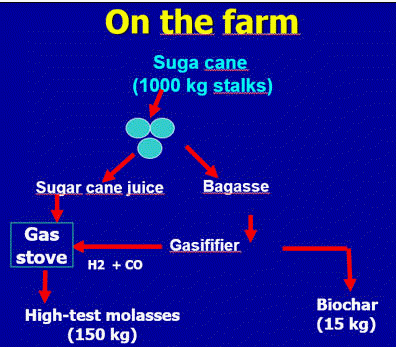 |
| Figure 6. Food, feed, energy and biochar from sugar cane |
The experiment done in México compared freshly extracted sugar cane juice with molasses in each case balanced with urea as fermentable source of nitrogen ad sunflower seed cake as the source of bypass protein (Figures 7 and 8) Live weight gain and feed conversion et were improved dramatically when sugar cane juice replaced molasses as the energy source, and when sunflower seed cake was provided as the source of bypass protein.
 | 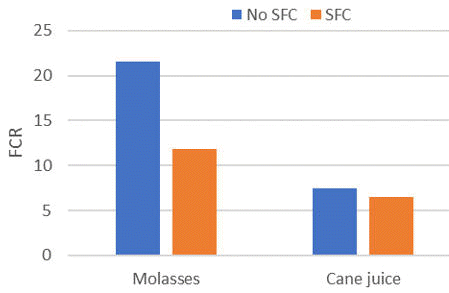 |
| Figure 7.
Growth rates of crossbred Zebu cattle are increased
threefold when basal diet of sugar cane juice and Star grass was supplemented with sunflower cake (Sanchez et al 1980) |
Figure 8.
Feed conversion of crossbred Zebu cattle is improved
threefold when a basal diet of sugar cane juice and Star grass was supplemented with sunflower cake (Sanchez et al 1980) |
Cereal straws are deficient in fermentable nitrogen and fermentable carbohydrates and should be upgraded by ensiling with urea, or ammonium bicarbonate, as demonstrated in China (Figure 9). Ensiling with urea or ammonium bicarbonate plays the dual role of improving fermentability and ensuring adequate levels of ammonia for synthesis in the rumen of microbial protein.
In Africa us common to find the use of hay made from natural or sown pastures. The reported data to composition (about 6% crude protein) indicates that it should be treated in the same was as for cereal straw.
Wheat straw was the basal feed resource, Ammonium bicarbonate was chosen for the ammonification process and cottonseed cake as the source of bypass protein of wheat straw was first submitted to a process of ammonation to increase the fermentability and provide ammonia for rumen microorganisms. The cottonseed cake was fed at increasing levels over the range 0 to 2.5kg/d. Ammonium bicarbonate was used at a rate of x kg of the alkali per ton of straw. (Figure 9).
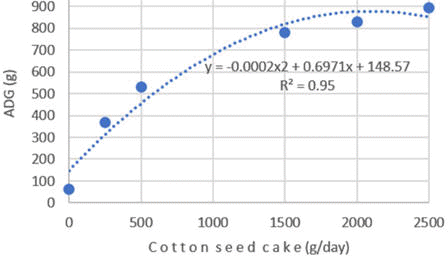 |
| Figure 9.
Fattening cattle with ammoniated wheat straw and cottonseed cake in China (Weixian et al 1994) |
The format used to present the diet demonstrates an important principle in experimental design and analysis when the aim is to define the animal (or plant) response to the supply of a given source of nutrients. Responses of this kind will in almost all cases follow the law of “diminishing returns” which states that the response to a given level of an input will steadily decrease s as the level of the input increases.
This plant is best known as a source of fiber for making packaging material generates massive amounts waste which has potential as the source of fermentable energy for ruminants. As has been demonstrated for other energy’rich byproducts, cattle fed sisal waste respond positively to supplementation with sources of bypass protein (Figures 10 and 11). This was one of the first examples of sourcing bypass protein from tree foliage. Foliage from the tree and rice polishings had similar and additive effects ts in improving both live weight gain and feed conversion.
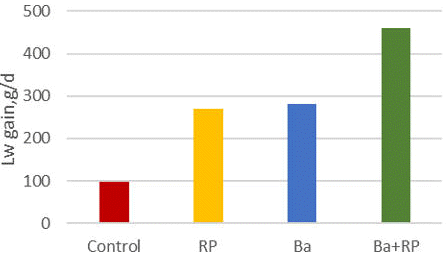 |  |
| Figure 10.
Supplements of leaves of Brosimum alicastrum and
rice polishing increase growth rates of zebu cattle fed a basal diet of sisal pulp-urea in Yucatan, Mexico |
Figure 11. Supplements of leaves of Brosimum alicastrum and
rice polishing improve feed conversion of zebu cattle fed a basal diet of sisal pulp-urea in Yucatan, Mexico |
The cassava plant can provide up to 96% all of the nutrients required for the fattening of cattle, Urea and minerals (2% of each) are the only additional supplements that are needed. This recommendation is based on the results of an experiment done in the Dominican Republic in 1997 (Figure 12). The experiment provided other relevant information supporting the general theme emphasized throughout this series of reports, namely the importance of the solubility of the protein destined for feeding to ruminants. When sweet potato leaves were the source of protein performance of the cattle was inferior to those fed cassava foliage and additional soybean meal was needed to improve animal response.
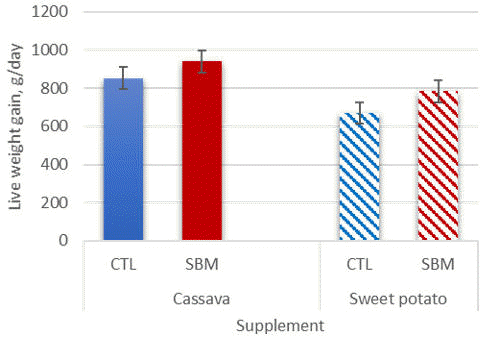 |
| Figure 12. Cassava foliage can supply all the bypass protein
needed to balance the energy and fermentable nitrogen in a basal diet of molasses/urea (Ffoulkes and Preston 1997) |
 |  |
| Photo 1. The open pit used to “store” the cassava pulp | Photo 2. Inserting PVC tubes to reach the bottom of the pit |
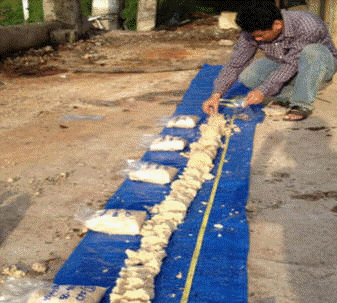 | 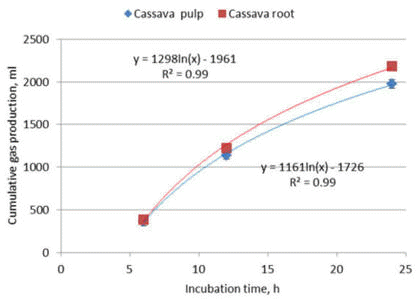 |
| Photo 3.The 10m “core” of ensiled cassava pulp | Figure 13. The “in vitro” fermentability of the “ensiled
“pulp was similar to that of the original cassava root (Phanthavong et al 2016) |
The positive results with cassava foliage in the Dominican Republic was the starting point for a series of experiments done in Laos PDR in the period 2015-2019. In response to my question? what agro-industrial byproducts are available in Laos? – the student took me to the “Tapioca” factory in the outskirts of the capital city -Vientiane. When I asked to see the byproducts. I was taken to what appeared to be a lake of decomposing organic matter (Photo 1), In fact it was a pit holding some 100,000 tonnes of cassava pulp which had accumulated over the 4 years since the factory began producing starch for export. A sample of the “waste” taken m1m below the surface revealed what appeared to be “ensiled” cassava pulp. Samples were then taken over the full depth (11m) of the pit (Photo 2). It was apparent (Photo 3) that the whole mass of pulp, from 1m below the surface had been perfectly preserved with an average pH of 3,2. The pit was open to the elements with the result that the surface layer to 1m depth saved as a protective cover for the mass of pulp below.
A test with the in vitro rumen incubation system showed that the ensiled pulp was equal ably fermentabls as the original cassava root (Figure 13).
The next step was to apply the experience gained in the Dominican Republic but with ensiled cassava pulp replacing molasses. The other contrasting experience was that the cassava foliage used in the Dominica Republic was a “sweet” variety as the custom was to plant cassava for human food. In contrast, the varieties used for starch production in Laos were of the bitter variety which and hugher yield potential. Both varieties were planted with the aim of comparing their nutritive values as supplements for cassava-pulp and urea.
However, when time approached to initiate the experiment the dry season had begun charactered by roving bands cattle looking for feed. The field of cassava was almost ready for harvesting and the roving bands of cattle were hungry and the fences were in need of repair. The results was: no cassava foliage for the experiment at the University!!
It was decided to look for a farmer who might have the resources to host the experiment. We found a farmer who with cattle ad facilities to feed them and who was interested in the idea; but there was no casava foliage! The solution was to procure brewers’ spent grains from the beer factory in the knowledge that this was a good course of bypass protein (Promkot and Wanapat 19-); A minimum quantity (1 kg/d) of rice straw was given as a source of “roughage” to stimulate rumen function. A sulphur-rich mineral mixture (50% common salt, 25% dicalcium phosphate, 20% calcium carbonate, 5% sulphur) was provided ad libitum. The urea was dissolved in water and sprayed on the cassava pulp. Brewers’ grains and rice straw were offered separately.
The response of the cattle to cassava pulp diet was remarkable (Photo 4). The local cattle in in Lao PDR, known as the: “Yellow” breed, are found throughout SE Asia. They are small in stature with mature bodyweights of about 300 kg. The photo of the cattle at the beginning of the experiment shows their typical emaciated condition at the end of the dry season. However, they quickly responded to the high nutritive value of the diet achieving an excellent body condition and production parameters after 120 days on the cassava pulp diet (Table 2; Photo 5).
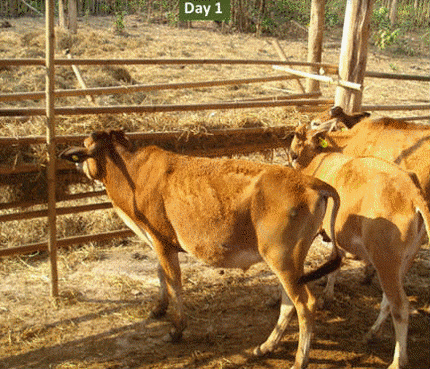 | 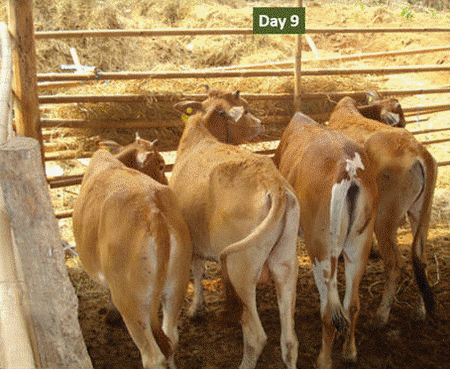 |
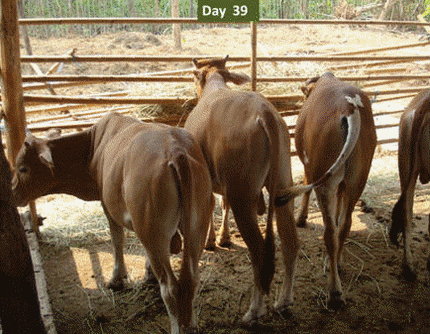 | 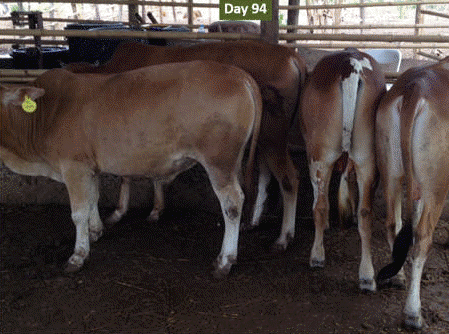 |
| Photo 4. The “Yellow” cattle at te beginning and at intervals throughout the fattening period | |
 | |
| Photo 5. The cattle at the ed of the 120 day experiment |
|
Table 2. Mean values for the feed intake, growth rate and feed conversion over the 120 days of the fattening period |
|||
|
Group 1 |
Group 2 |
||
|
Live weight, kg |
|||
|
Initial |
101 |
84.0 |
|
|
After 120 days |
185 |
158 |
|
|
Daily gain |
0.700 |
0.620 |
|
|
Feed intake, kg/day |
|||
|
Cassava pulp |
11.3 |
9.57 |
|
|
Brewers' grains |
4.87 |
4.13 |
|
|
Urea |
0.11 |
0.090 |
|
|
Rice straw |
1.23 |
1.04 |
|
|
Minerals |
0.080 |
0.070 |
|
|
Total DM |
4.82 |
4.10 |
|
|
DM feed conversion |
6.43 |
7.05 |
|
|
On a DM basis, the diet contained: cassava pulp 51%, Brewers grains 23%, urea 2.2%, Rice straw 22%, minerals 1.4% |
|||
It is important to stress the difference between sweet and bitter cassava from three points of view: (i) as a source of bypass protein; (ii) as a means of reducing emissions of enteric methane; and (iii) their potential toxicity due to release of HCN in the animal.
An experiment to compare the relative merits of Brewer ‘grains and “sweet “cassava foliage as sources of bypass protein showed an interaction between these two supplements with the optimum combination being 75% of the protein from cassava foliage and 25% from brewers” grains (Figure 14). We suggest this interaction reflects the specific characteristics of these two feed resources; cassava foliage contains cyanogenic glucosides that give rise to hydrocyanic acid in the animal. These substances are toxic to methanogenic bacteria. This is well demonstrated by the data in Figure 15, which shows the rapid decline in methane emissions as the level of casava foliage in the diet was increased. The explanation for the better growth by retaining some brewers’ grains in the diet is that they are a means of reducing HCN toxicity as demonstrated in the research of Binh et al (2015)
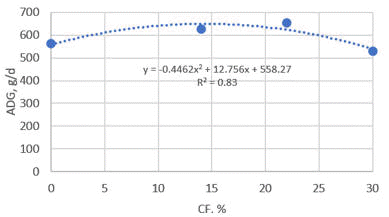 | 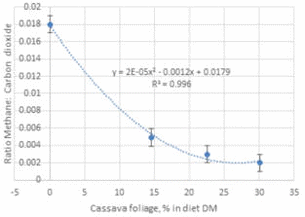 |
| Figure 14.
Live weight gain is increased a fresh cassava foliage replaces up to 75% of the brewers’ grains brewers’ grains, but declines when all the brewers’’ is replaced by cassava |
Figure 15. Methane emissions are reduced
when cassava foliage replaces Brewers’ spent grain in a fattening diet based on ensiled cassava pulp |
Further evidence for the interaction between cassava foliage and brewers’ grains is apparent from the results shown in Figure 16. Lie weight gain was not affected wen 50% of the brewers’ grains was replaced by butter cassava foliage but were severely reduced when all the supplementary protein was from butter cassava.
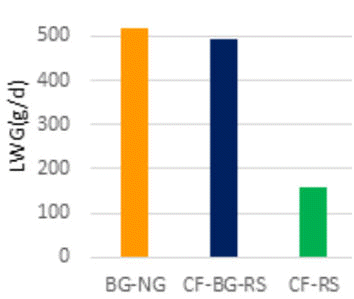 |
| Figure 16. Effect on growth rate of “Yellow” cattle fed casava
pulp-urea and protein from combinations of bitter cassava foliage and brewers’ grains (Phanthavong et al (2016) |
One feature of the research with cassava root pulp is that high performance is possible (Figure 17) when brewers’ grains are used as the source of bypass protein and rice straw is the source of fiber and these feeds are not mixed except for urea which is mixed with the cassava pulp.
Total mixed rations do not appear to offer any advantages to small and medium scale producers. It has also been observed that cattle are selective eaters and giving them the opportunity to reject or to limit the intake of bitter cassava foliage would appear to be a sensible strategy.
 |
| Figure 17. Live weight gain/feed conversion of “Yelow”cattle fed TMR or
EMR containing bitter cassava foliage as protein source; the control group were fed brewers’ grains as protein source and rice straw as source of fiber with all feeds offered separately |
This approach works well with goats that voluntarily select and consume equal quantities of sweet and bitter cassava foliage when they ha ethe opportunity (Figure 18). That animal wisdom results in practical decisions by the animals themselves is apparent from the results in Figure 19 which shows that gats having free access to both sweet and bitter cassava selected equal quantities of bioth and perform better than when they were fed only the sweet variety (an N retention of 10 g/d is equivalent to >120/d of live weight gain). There is reason to believe that “native” Yellow cattle would also show wisdom in feed selection as indicated in Figure 17.
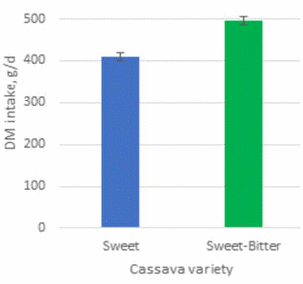 |
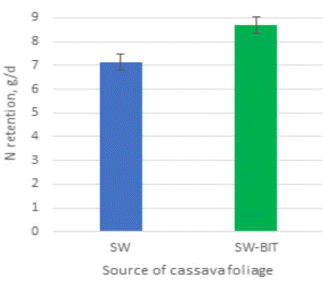 |
| Figure 18. Goats eat more cassava foliage wen they have free access to both sweet and butter varieties of which they ate equal quantities |
Figure 19. N retention was increased by 25% wen the goats has equal access to both sweet and bitter cassava foliage as compared with sweet cassava alone |
Attempt to replace the brewers ‘grains with cassava foliage indicate:
Antari R, Ningrum G P, Pamungkas D, Mayberry D E, Marsetyo and Poppi D P 2016 Growth rates and feed conversion rate of Ongole, Limousin-Ongole and Brahman bulls fed elephant grass (Pennisetum purpureum). Livestock Research for Rural Development. Volume 28, Article #170. http://www.lrrd.org/lrrd28/9/anta281
Binh P L T, Preston T R, Duong K N and Leng R A 2017 A low concentration (4% in diet dry matter) of brewers’ grains improves the growth rate and reduces thiocyanate excretion of cattle fed cassava pulp-urea and “bitter” cassava foliage. Livestock Research for Rural Development. Volume 29, Article #104. http://www.lrrd.org/lrrd29/5/phuo29104.html
Ffoulkes D y Preston T R Cassava or sweet potato forage as combined sources of protein and roughage in molasses based diets: effect of supplementation with soybean meal. Tropical Animal Production 3:3 PP 186-192\
Jarvis A, Ramirez-Villegas J, Herrera Campo B V and Navarro-Racines C 2012 Is Cassava the Answer to African Climate Change Adaptation? Tropical Plant Biology.5 (1) 9-29.
Keopaseuth T and Preston T R 2017 Cassava (Manihot esculenta Cranz) foliage replacing brewer’s grains as protein supplement for Yellow cattle fed cassava pulp-urea and rice straw; effects on growth, feed conversion and methane emissions. Livestock Research for Rural Development. Volume 29, Article #35. http://www.lrrd.org/lrrd29/2/toum29035.html
Phanthavong V, Viengsakoun N, Sangkhom I and Preston T R 2014 Cassava pulp as livestock feed; effects of storage in an open pit. Livestock Research for Rural Development. Volume 26, Article #169. http://www.lrrd.org/lrrd26/9/phan26169.htm
Phanthavong V, Khamla S and Preston T R 2016 Fattening cattle in Lao PDR with cassava pulp. Livestock Research for Rural Development. Volume 28, Article #10. http://www.lrrd.org/lrrd28/1/phan28010.html
Phanthavong V, Preston T R, Viengsakoun N and Pattaya N 2016 Brewers' grain and cassava foliage (Manihot esculenta Cranz) as protein sources for local “Yellow” cattle fed cassava pulp-urea as basal diet. Livestock Research for Rural Development. Volume 28, Article #196. http://www.lrrd.org/lrrd28/11/phan28196.html
Phanthavong V, Preston T R, Vorlaphim T, Dung D V and Ba N X 2018 Fattening “Yellow” cattle on cassava root pulp, urea and rice straw: completely mixed ration system with cassava foliage as protein supplement compared with feeds not mixed and brewers’ grains as protein source. Livestock Research for Rural Development. Volume 30, Article #169. http://www.lrrd.org/lrrd30/10/phan30169.html
Phuong L T B, Preston T R, Van N H and Dung D V 2019 Effect of additives (brewer’s grains and biochar) and cassava variety (sweet versus bitter) on nitrogen retention, thiocyanate excretion and methane production by Bach Thao goats. Livestock Research for Rural Development. Volume 31, Article #1. http://www.lrrd.org/lrrd31/1/phuong31001.html
Preston T R, Leng R A, Inthapanya S and Gomez M E 2021 The rumen in vitro incubation system as a tool for predicting the nutritive value of ruminant diets and the associated emissions of methane. Livestock Research for Rural Development. Volume 33, Article #74. http://www.lrrd.org/lrrd33/6/3374prest.html
Preston T R and Willis M B 1974 Intensive Beef Production Pergan Press, Oxford UK.
Preston T R, Carcaño C, Alvarez F J and Gutierrez D G 1976 Rice polishings as a supplement in a sugar cane diet effect of level of rice polishings and of processing the sugar cane by derinding or chopping. Tropical Animal Production Volume 3, No Page 1-14
Preston T R, Leng R A, Inthapanya S and Gomez M E 2021 The rumen in vitro incubation system as a tool for predicting the nutritive value of ruminant diets and the associated emissions of methane. Livestock Research for Rural Development. Volume 33, Article #74. http://www.lrrd.org/lrrd33/6/3374prest.html
Sanchez M and Preston T R 1980 Sugar cane juice as cattle feed: comparisons with molasses in the presence or absence of protein supplement. Tropical Animal Production, Voilume5:2 Page 117
Weixian Z, Xue G C, Dolberg F and Finlayson P M 1994 Supplementation of ammoniated wheat straw with hulled cottonseed cake. Livestock Research for Rural Development. Volume 6, Article #9. http://www.lrrd.org/lrrd6/1/china1.htm
Whitelaw F G and Preston T R 1963 The nutrition of the early-weaned calf III. Protein solubility and amino acid composition as factors affecting protein utilization Animal Production / Volume 5 / Issue 02 / June 1963, pp 131 – 145 DOI: 10.1017/S0003356100021620, Published online: 02 September 2010. http://journals.cambridge.org/abstract_S0003356100021620.